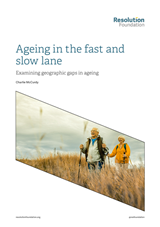Ageing in the fast and slow lane: Examining geographic gaps in ageing

Ageing is playing out differently in different parts of the UK, both in terms of places’ age profile, but also in terms of the rate at which places are ageing. This briefing note from the Resolution Foundation explores these trends and draws out some implications for local public services.
The report examines the geography of ageing across the country, focusing on the scale of age differences between areas, how these gaps have evolved over the 21st century, what drives them, and their implications for public services. Key findings include:
- There are large age gaps between the UK’s oldest places (North Norfolk, with a median age of 55 in 2022) and its youngest places (Tower Hamlets, with a median age of 31 in 2022).
- These gaps are growing, because many of the UK’s oldest places are ageing rapidly, while many young areas are either getting younger or ageing less quickly than the UK overall.
- The UK’s fastest-ageing places over the past 20 years are all coastal or rural areas, and many are in Scotland.
- Over the past decade or so London has experienced more ageing (its median age has rose by 2 years between 2011 and 2022) than other large UK cities (where the median age in 2022 was roughly unchanged on 2011).
- These demographic shifts have important implications for local public services, with an obvious implication for adult social care in places with large elderly populations.
- The authors find that adult social care spending per elderly person is negatively correlated with the size of the local elderly population, implying areas facing the highest demand for social care services aren’t able to fund those services at the same level as places with lower demand.
